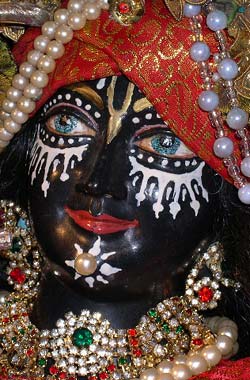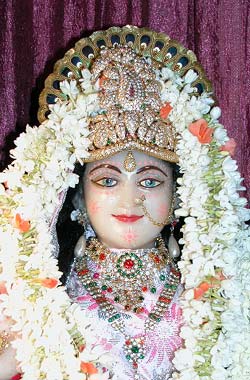

There is a great misunderstanding in both the secular and religious worlds, especially within the Abrahamic traditions (Judaism, Islam, and Christianity), regarding the question of Deity worship that is equated with idol worship.
The English word idol is commonly used to describe any form of worship involving likenesses of demons, gods, goddesses, Viṣṇu, or Kṛṣṇa. In the West, the term idol carries a highly negative connotation, evoking images of pagans, heathens, and other uncultured people engaging in the worship of animals or half-animal, half-human horned aberrations in the form of statues. These idols are often associated with lascivious activities such as unrestricted sex, the use of various intoxicants, and even human sacrifice. Moreover, they are typically depicted as mean-spirited and driven by lust.
The American Heritage Dictionary defines an idol as follows:
- An image used as an object of worship.
- A false god.
- One that is adored, often blindly or excessively.
- Something visible but without substance.
This standard dictionary definition leaves no room for doubt—idol worship is regarded as bad and sinful according to mainstream Western religious traditions.
Satchitananda Bhaktivinoda Ṭhākura’s Response to the Idol Worship Debate
Śrīla Bhaktivinoda Ṭhākura, one of the foremost devotees of Lord Kṛṣṇa in the 19th century, addresses the question of idolatry in his book Śrī Caitanya Mahāprabhu: His Life and Precepts. Written for missionary purposes, Bhaktivinoda Thakur sought to introduce the teachings of Sri Krishna Caitanya to the Western world. The book was published in 1896, the very year that Śrīla A. C. Bhaktivedanta Swami Prabhupāda made his appearance in this world. This booklet found its way into the library of McGill University in Canada, the library of the Royal Asiatic Society of London, and several other highly respected institutions. Even today, it remains available in many libraries across the Western world.
The Perception of Deity Worship as Idolatry
Śrīla Bhaktivinoda Ṭhākura acknowledged that some object to the concept of worshipping the Deity, or Śrī-mūrti (the Deity form of Lord Kṛṣṇa).
He wrote:
"They say, 'It is idolatry to worship Śrī-mūrti. Śrī-mūrti is an idol formed by an artist and introduced by none other than Satan himself. Worshipping such an object would arouse the jealousy of God and limit His omnipotence, omniscience, and omnipresence!' To this, we reply, 'Brethren! Candidly understand the question and do not allow yourselves to be misled by sectarian dogmas. God is not jealous, as He is one without a second. Satan is nothing more than an object of the imagination or the subject of an allegory. An allegorical or imaginary being should not be allowed to act as an obstacle to the development of our loving relationship with God.'"
The Absurdity of Deifying Evil
Those who have personified evil in an imaginary being called Satan are, in truth, engaged in idolatry themselves because they attribute substance to that which has no real existence. Bhaktivinoda Ṭhākura conveys this same understanding in his writings.
The Irony of Rejecting Deity Worship While Embracing Satanic Imagery
The very people who decry the bona fide method of Deity worship as idolatry cannot provide a clear or substantial description of God. However, they have gone to great lengths to depict an evil figure called Satan or Lucifer, complete with horns and a three-pronged fork, overseeing the fires of hell. Every person raised in the West has this image ingrained in their mind, yet they lack a clear image of God. The irony here sticks out like a sore thumb.
Speaking on the Abrahamic religions, Śrīla Bhakti Rakṣaka Śrīdhara Deva Gosvāmī Mahārāja, clearly states:
"Some conception of God is there, but it is not so much developed as we find in Hindu ontology, or in the Vedas or Upaniṣads—in the revealed scriptures." (Divine Aspirations)
The Abrahamic religions, in comparison, exhibit a less developed theological depth, a point subtly acknowledged by the Guardian of Devotion Srila Sridhara Maharaja. Hindu ontology, encompassing the worship of divinities such as Śiva, Durgā, and Hanumān in their Deity forms, presents a more refined and comprehensive understanding of theism.
Still, the acknowledgment of God as the all-powerful Supreme Being ensures that the Abrahamic religions maintain a fundamental connection to theism. This foundation enables their followers to cultivate reverence, devotion, and moral discipline, which is an essential step in the spiritual journey. However, due to the limitations of their theological framework, these traditions often lack the depth of realization and intimate understanding of the Lord’s personal form, attributes, and transcendental pastimes as revealed in the Vedic scriptures.
The Gauḍīya Vaiṣṇavas, in a spirit of humility and openness, respectfully invite sincere seekers from these traditions to explore a more profound conception of the Divine—one that not only acknowledges His supreme majesty, power and compassion but also reveals His all-attractive, personal nature, full of loving exchanges with His devotees
In this regard, different religions can be categorized similarly to how we categorize education. All are valuable whether one is in kindergarten or has advanced to postgraduate studies. No reasonable person belittles someone in grammar school. All levels of theism play a vital role in the jiva's journey back to Godhead.
Naturally, wherever a devotee finds himself on the spiritual journey, he will feel, "My path is the best." And for him, it is—because it aligns with his current realization and meets his spiritual needs at that stage. However, true wisdom requires walking the path of faith with humility and generosity, respecting others who may be following a different course.
Śrī Caitanya Mahāprabhu instructs: "tṛṇād api sunīcena taror api sahiṣṇunā"—one should be humbler than a blade of grass and more tolerant than a tree. Recognizing that every sincere pursuit of the Divine holds its rightful place in the grand design of spiritual evolution. We should not be distracted by sectarian disputes. Rather than engaging in ideological warfare, we strive to cultivate understanding, humility, and a deep appreciation of the essence common to all genuine religious traditions.l
Namacharya Haridās Ṭhākura powerfully conveys this truth while engaging in a discussion on theism with the Kazi, the Muslim magistrate of Bengal during the 15th century. In this exchange, he emphasizes that all living beings are guided by the Lord within their hearts and act according to divine inspiration. He states:
“All living entities in creation are inspired by the Lord in the heart to act in different ways. People of different religions praise the Lord’s holy names and qualities according to the view of their scriptures. The Supreme Lord accepts everyone’s mood. If anyone shows malice towards another’s religion, he actually shows malice to the Lord Himself, who is worshiped by that religion. Since God is one, that person becomes envious of the same Supreme Lord that he himself is worshiping.”
This statement, recorded in Caitanya-bhāgavata, Madhya-khaṇḍa (by Śrīla Vṛndāvana dāsa Ṭhākura), highlights the futility of sectarian envy.
While the Kali Yuga is rife with fabricated ideologies that lack the eternal foundation of Vaiṣṇava dharma, devotees should exercise discernment without arrogance. All who acknowledge the existence of one Supreme Lord should be met with dignity and respect, as genuine devotion is not fostered through hostility but through spiritual integrity. Devotees navigate these differences with wisdom and humility. Rather than fostering animosity, tṛṇād api sunīcena… we should not forget that all are servants of Kṛṣṇa, whether they realize it or not.
The Personal and Beautiful Nature of God
In his book, Śrīla Bhaktivinoda Ṭhākura—a pure lover of Kṛṣṇa with the deepest transcendental insight—reveals that God is personal and all-beautiful. His holy and perfect personality exists eternally in the spiritual world of Vaikuṇṭha, the transcendental abode of The Supreme Lord. He is identical to His all-beautiful form, possessing such divine attributes as omnipresence, omniscience, and omnipotence. He is complete with six opulences in full: all wealth, all power, all renunciation, all wisdom, all fame, and all beauty.
Descriptions of Kṛṣṇa by His Pure Devotees
While some religious traditions assert that God cannot be seen, saints and realized souls, the sadhus who have directly served Him present a different perspective. They confirm His existence and offer profound insights into His divine form, nature, pastimes, and abode. Their descriptions transcend abstract philosophy, providing vivid details of His appearance, transcendental residence, close associates, and loving relationships He shares with all His servants.
Through their deep spiritual realization, they reveal the Supreme's personal and intimate nature. They demonstrate that He is not a distant or impersonal force but a being who engages in loving exchanges with His devotees. Their testimonies invite seekers to move beyond theoretical understanding and develop a direct, heartfelt connection with the Divine.
The Scriptural Authority Supporting Deity Worship
This truth is supported by volumes of transcendental revealed scripture, such as the Śrīmad-Bhāgavatam and the Bhagavad-gītā.
The pure lovers of Kṛṣṇa, who have seen Him face to face, have left us descriptions of this most wonderful person. Therefore, Bhaktivinoda Ṭhākura states:
"According to those descriptions, one delineates a Śrī-mūrti and sees the great God of our heart there with intense pleasure. Brethren! Is that wrong or sinful?"
The Importance of Deity Worship
The ācāryas, coming in disciplic succession through the Brahma-Madhva-Gauḍīya Vaiṣṇava sampradāya, teach that worshiping Kṛṣṇa in His Deity form is not only not sinful but also one of the paramount practices of devotion.
Furthermore, Kṛṣṇa Himself mocks those who fail to recognize Him as the Supreme Lord of all that exists. Those who criticize Kṛṣṇa and His worship are deemed foolish by the Supreme Lord Himself. This was instructed by the Supreme Lord during the Battle of Kurukṣetra 5,000 years ago.
अवजानन्ति मां मूढा मानुषीं तनुमाश्रितम् ।
परं भावमजानन्तो मम भूतमहेश्वरम् ॥ ११ ॥
avajānanti māṁ mūḍhā
mānuṣīṁ tanum āśritam
paraṁ bhāvam ajānanto
mama bhūta-maheśvaram
"Fools deride Me when I descend in the human form. They do not know My transcendental nature as the Supreme Lord of all that be." (Bhagavad-gītā 9.11)
Bhaktivinoda Ṭhākura Clarifies the Difference Between Deity Worship and Idolatry
Śrīla Bhaktivinoda Ṭhākura continues:
"Those who say that God has no form, either material or spiritual, and at the same time imagine a false form for worship are certainly idolatrous. But those who see the spiritual form of the Deity with the eyes of their soul, carry that impression as far as possible to the mind, and then frame an emblem for the satisfaction of the material eye for continual study of the higher feeling are by no means idolatrous. When seeing a Śrī-mūrti, do not even see the image itself; rather, see the spiritual model of the image, and you are a pure theist. Idolatry and Śrī-mūrti worship are two different things!"
The Reality of Idol Worship in the Material World
It is a fact that idol worship exists on this earth. The worship of imagined entities takes place across the world, from India to America. From the Bohemian Grove in Monte Rio, California, where many famous and influential individuals gather, to the small enclaves of witches and warlocks who continue to venerate Hecate, the Greek goddess of magic, witchcraft, and the night—idol worship remains a thriving practice.
However, the beautiful form of Kṛṣṇa does not fall into this category. Even the forms of various demigods, whose descriptions are found throughout the revealed scriptures, represent a legitimate method of worship, even if not observed by Gauḍīya Vaiṣṇavas. Kṛṣṇa Himself states that the worship of demigods is for the less intelligent, yet these divinities undeniably exist, and through their worship, many have attained material boons.
antavat tu phalaṁ teṣāṁ
tad bhavaty alpa-medhasām
devān deva-yajo yānti
mad-bhaktā yānti mām api
"Men of small intelligence worship the demigods, and their fruits are limited and temporary. Those who worship the demigods go to the planets of the demigods, but My devotees ultimately reach My supreme planet." (Bhagavad-gītā 7.23)
We might ask our readers, particularly those who hold an affinity for scriptures and dogmas that lack a clear definition of the Godhead and condemn the worship of Kṛṣṇa as "idol worship," to reconsider their sentiments.
As Bhaktivinoda Ṭhākura has stated:
"Do not allow yourself to be misled by sectarian dogmas."
Caitanya Mahāprabhu placed great emphasis on worshiping Śrī-mūrti, ranking it among the highest practices of devotion. This includes associating with devotees, residing in a holy dhāma (place of pilgrimage), hearing Śrīmad-Bhāgavatam, and chanting the Holy Name.
Satchitananda Bhaktivinoda Ṭhākura states:
"To tell you the truth, Śrī-mūrti worship is the only true worship of the Deity, without which you cannot sufficiently cultivate your religious feeling. The world attracts you through your senses, and as long as you do not see God in the objects of your senses, you live in an awkward position, which scarcely helps you in procuring spiritual elevation. Place a Śrī-mūrti in your house. Think that God Almighty is the guardian of the home. Offer food to Him and take it as His prasāda (mercy). Flowers and scents should also be offered to Him and accepted as prasāda. The eye, ear, nose, skin, and tongue all have a spiritual culture. If you do it with a holy heart, God will know it and judge you by your sincerity. If divine compassion, love, and justice could be portrayed by the pencil and expressed by the chisel, then why shouldn't the personal beauty of the Deity be portrayed in poetry, in pictures, or expressed by the chisel for the benefit of man?"
At the time of writing Śrī Caitanya Mahāprabhu: His Life and Precepts, Śrīla Bhaktivinoda Ṭhākura was entering uncharted waters, seeking to persuade the people of the West to consider the creed of the Gauḍīya Vaiṣṇavas and to learn about Śrī Kṛṣṇa Caitanya Mahāprabhu. No doubt, he spoke in a way that would not offend those he was trying to bring into Mahāprabhu’s fold. Yet, even so, if we read between the lines, the Ṭhākura makes some remarkably strong statements, subtly chastising Christians for creating an idol called the devil while simultaneously criticizing the worship of bona fide Deities. The Ṭhākura boldly calls upon the Christian world to embrace and engage in the worship of Śrī-mūrti!
It is worth reflecting on the following: When an individual desecrates the Bible, Qur'an, or Torah, it is considered a profound insult by those who revere these texts as the word of God. In some Islamic countries, defiling the Qur'an is even punishable by death. Similarly, many Christians and Jews regard the desecration of their sacred scriptures as a grievous offense. Those who revere these texts handle them with the utmost care, recognizing their sanctity. Why is this? Because they understand that God is present in these scriptures. Yet, what are these texts composed of in their physical form? They consist merely of material elements—paper, ink, and bindings.
If God Can Manifest in Scripture, Why Not in the Deity?
So how is it any different when Kṛṣṇa manifests in the Deity form, which is likewise made of material elements? If divinity can be present in scripture, why can it not also be present in the Deity?
Śrīla A. C. Bhaktivedanta Swami Prabhupāda has written in the Śrī Caitanya-caritāmṛta:
"Because the material elements are the Lord's own energy and because there is no difference between the energy and the energetic, the Lord can appear through any element. Just as the sun can act through the sunshine and thus distribute its heat and light, so Kṛṣṇa, by His inconceivable power, can appear in His original spiritual form in any material element, including stone, wood, paint, gold, silver, and jewels, because the material elements are all His energy. The scriptures warn that one should never think of the Deity within the temple as simply stone, wood, or any other material element.”
Not only do the followers of Mahāprabhu worship the beautiful form of Kṛṣṇa, but they also hold the view that anyone who perceives such forms as material or decries them is in the material mode of ignorance.
How Does the Deity Form of God Interact with Surrendered Souls?
The interaction between God's Deity form and surrendered souls can be understood through a simple yet profound analogy: the authorized mailbox. If one places a letter in a government-authorized mailbox, it will undoubtedly reach its intended destination. However, if someone erects their own mailbox without proper authorization, the letters placed there will never be delivered.
Similarly, those who are established in divine love, having tasted prema, seen the Supreme Lord, and directly perceived His presence, are truly qualified to install His sacred form. When such realized souls establish His Śrī-mūrti, Kṛṣṇa, by His inconceivable potency, fully accepts that form as His own and reciprocates with the devotion offered to Him. In this way, prayers, offerings, worship, and all other expressions of bhakti directed toward the authorized Deity genuinely reach the Supreme Lord Himself.
The Consequences of Unauthorized Worship
However, without proper authorization, if one relies on their imagination to fabricate a form of worship, then that image remains lifeless and devoid of divinity. Such unauthorized worship yields no spiritual benefit and produces only bitter results, as is the nature of all idolatry. True Deity worship follows a transcendental process, ensuring that the worshiper’s devotion reaches its rightful destination—the lotus feet of the Supreme Lord.
The Ritvik Deviation: Idol Worship Within Gauḍīya Vaiṣṇavism
To provide a balanced perspective, it is important to acknowledge that, even within what appears to be the Gauḍīya Vaiṣṇava tradition, certain forms of idol worship have emerged. This is particularly evident in the Ritvik system, whose proponents have attempted to elevate Śrīla A. C. Bhaktivedanta Swami Prabhupāda to a Christ-like figure, disregarding a foundational pillar of Gauḍīya siddhānta—that one must accept a living spiritual master.
By rejecting this essential principle, they lead their followers down a misguided path. They idolize statues of Śrīla Prabhupāda while remaining disconnected from the true process of spiritual realization through the guru parampara system. In reality, the statues they revere are lifeless, because the great saint Śrīla Prabhupāda is not present there. Those who engage in such practices neither truly know him nor share any genuine spiritual connection with him, as their so-called worship lacks the living, dynamic relationship between guru and disciple that is central to authentic Gauḍīya Vaiṣṇavism.
The only way to establish a connection with Śrīla Prabhupāda is to follow him in the guru parampara disciplic succession. If one has a bona fide living guru, then all the ācāryas are present within him including Srila Prabhupada.
Kṛṣṇa Himself reiterates the necessity of a living guru:
tad viddhi pranipatena
pariprasnena sevaya
upadeksyanti te jnanam
jnaninas tattva-darsinah
"Just try to learn the truth by approaching a spiritual master. Inquire from him submissively and render service unto him. The self-realized soul can impart knowledge unto you because he has seen the truth." (Bhagavad-gītā 4.34)
Jagad Guru Swami Narasiṅgha Mahārāja says —
"Actually, the Ṛtviks are not a sampradāya… Ṛtvik conception falls under the category of apa-sampradāya (false sampradāya) or the anti-party section. Apa-sampradāya refers to preaching against the principles and practices of pure devotional service, while sahajiyā means to imitate the real process of pure devotion.
In this way, the Ṛtviks have become a sahajiyā apa-sampradāya because their process eliminates the real thing and attempts to establish an illusory standard under false pretenses. Similarly, one could consider the Ṛtviks as māyāvādīs. Māyāvāda means the philosophy of illusion." —Jagad Guru Swami Narasiṅgha Mahārāja
Krsna, the Lord of all that be, is all-powerful, and He may appear anywhere at any time and through any element He so chooses. If His devotee desires He appears in His Sri-murti form, He can do it. Not only does Krsna appear to us as Sri-murti but He relishes accepting the love and devotion rendered to Him by those, who, with a pure heart, serve Him selflessly in that form.
All glories to Sri-murti , the transcendentally beautiful form of Krsna, resplendent with all opulence, the storehouse of all transcendental bliss and rasa.
OM TAT SAT




